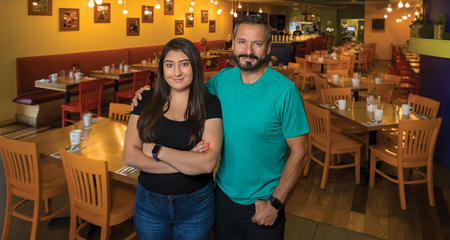
Colonoscopy or At-Home Colon Cancer Test Kit? You Have Options.
At-home colon cancer tests detect abnormalities in the stool that could indicate polyps or cancer.


Colon cancer is the second-leading cause of cancer-related death following lung cancer, but it is one of the most preventable cancers — if you get screened. A colon cancer screening allows your doctor to detect colon cancer and find abnormal growths that could become cancerous many years later.
“Screenings are the most important tool for reducing the incidence and death rate of colon cancer,” said Kirk Ludwig, MD, colorectal surgeon and chief of colorectal surgery with the Froedtert & the Medical College of Wisconsin Cancer Network. “When we find colon cancer in its early stages, treatments are very effective.”
Colon cancer starts out as a pre-cancerous lesion on the lining of the colon, called a polyp. Many polyps do not cause symptoms right away, which is why routine screenings are so important. Routine screenings are recommended for people at average risk beginning at age 45, but according to the Centers for Disease Control and Prevention, only 69% of Americans are up-to-date on their screenings.
Types of colon cancer screening
Several tests can be used to find polyps or colon cancer. You can do some of them at home; others require a clinic setting due to the expertise and type of technology needed. Colon cancer at-home tests are stool-based, whereas tests done in a clinic allow for direct visualization of the colon.
Colonoscopy: In-clinic test
A colonoscopy is an exam of the rectum and the colon with a slender flexible tube and camera. Before the procedure, there is some preparation required to empty your colon of feces. Expect to make some modifications to your diet the day before your colonoscopy and to be provided with a liquid to drink for the bowel preparation. During the procedure, you will be under light sedation.
A colonoscopy is considered the gold standard for colon cancer screening because it is diagnostic and therapeutic, which means that your doctor can not only find polyps and cancers, but can also remove them during the exam. This test is done every 10 years if you are at average risk of developing cancer and no polyps are found during your exam. Your doctor may recommend more frequent screening if polyps are discovered or if you have risk factors.
“At least 20% of colonoscopies find polyps,” Dr. Ludwig said. “The majority of polyps cause no symptoms and many of the people we screen and diagnose with colon cancer are people who are not considered at risk.”
Flexible Sigmoidoscopy: in-clinic test
A flexible sigmoidoscopy is similar to a colonoscopy, but the exam evaluates only the lower part of the colon instead of the whole colon and the rectum. Some people prefer to have a flexible sigmoidoscopy because the preparation and the exam take less time than for a full colonoscopy, and sedation may not be necessary. A flexible sigmoidoscopy, done every five years, is sometimes combined with a FIT test, which is a colon cancer at-home test that uses antibodies to detect blood in the stool.
CT Colonography: in-clinic test
Computer tomography (CT) colonography uses X-rays and computers to view the entire colon. No endoscope is needed for this exam because the CT scan will generate a detailed image of your colon. Your doctor will be able to view polyps in the colon on the CT scan, but will not be able to remove them in the moment. If polyps are detected, a colonoscopy will need to be scheduled. You will be restricted to clear fluids prior to the exam, so your doctor can have better visualization of the colon.
Guaiac-based fecal occult blood test (gFOBT): at-home test
The gFOBT test uses a chemical testing solution called guaiac to detect blood in the stool that is not visible to the naked eye. Blood in the stool can be a symptom of colon cancer because blood vessels in some larger polyps may tear and bleed into the colon or rectum with the passage of stool.
Before taking this test, there are certain foods and medications to avoid because they may affect test results. Your test kit will come with instructions that will explain how you will collect your stool samples. Three samples are required, and each should be from a different bowel movement. They should be collected with an applicator stick and applied to the test card provided. When samples are completed, you will mail them to the lab for testing. This colon cancer at-home test should be done once a year.
Fecal immunochemical test (FIT): at-home test
The FIT test is similar to the gFOBT test in that it also detects blood in the stool, but instead of using a chemical to do so, it uses antibodies. The test is a little bit easier to do than the gFOBT test because it only requires you to collect one stool sample, not three. Instructions will be provided with your test kit that explain how to collect the sample and place it into the tube provided with the test kit. When the sample is completed, you will mail it to the lab for testing. This test should be done once a year.
FIT-DNA test: at-home test
The FIT-DNA test works like the FIT test in that it uses antibodies to detect blood in the stool, but it can also detect changes in DNA that are associated with cancer in the stool. The FIT-DNA test is also known as the Cologuard® test.
One important difference between this colon cancer at-home test and others is that the FIT-DNA test requires a whole stool sample. A small quantity of the whole sample is also collected with a swab and needs to be sent in for testing. The test kit comes with the swab, a container for the whole sample and preservative solution. Using the box and prepaid label, you will need to ship the container and sample to the lab the same day or the next day. This test should be done every one or three years, depending on the screening guidelines you follow or your provider recommends.
What are the benefits to colon cancer at-home tests?
- Comfort and convenience. Colon cancer at-home tests can be done in the comfort of your home and at the convenience of your schedule, as no appointment is needed for you to do the at-home test.
- No bowel preparation needed. Unlike the in-clinic tests, colon cancer at-home tests do not require bowel preparation. The gFOBT does have dietary restrictions, so be sure to read the instructions carefully before you begin.
- Less expensive. At-home tests are covered by most insurance plans. They can be less expensive than an in-clinic test. Check with your insurance company to find out what your plan covers.
What are the drawbacks to at-home colon cancer tests?
- At-home colon cancer tests are not for everyone. These tests are only recommended for people at average risk for colon cancer. Average risk means you have no personal or family history of colon or rectal cancer, no personal or family history of polyps and no personal history or other diseases or conditions that affect the colon or the rectum.
- Less accurate. At-home colon cancer tests do not allow for an exam of the colon or rectum, so they are less accurate than an in-clinic test. They can also have false-positive results.
- You cannot receive treatment in the moment. A big drawback for at-home colon cancer tests when compared to colonoscopies is that if your result on the at-home test is positive, you will need to schedule a colonoscopy for further investigation. A colonoscopy is the only way for a doctor to remove the cancer or polyp. In some cases, the colonoscopy will find the at-home test had a false-positive result, which is an additional drawback.
- You will have to test more frequently. When you choose to do a colon cancer at-home test, you will have to repeat this test more frequently than if you were to have an in-clinic test. For some at-home tests, the recommended screening frequency is every year, whereas a colonoscopy only needs to be done once every 10 years for someone at average risk.
- Discomfort handling your own stool. All three types of colon cancer at-home tests require you to take a sample of your stool. The gFOBT test requires you to take a small sample of three different bowel movements, the FIT test requires a small sample from only one bowel movement and the FIT-DNA test, or Cologuard, requires you to place a full movement in a container as well as to gather a small sample.
How do at-home colon cancer tests work?
Colon cancer at-home tests are obtained with a prescription from your primary care provider. You send in the results to the lab for evaluation. The at-home tests all evaluate the stool for changes that could indicate polyps or cancer. Blood in the stool can be an early symptom for polyps. If results for any of these tests are positive, a follow-up colonoscopy is the next step.
The U.S. Preventive Services Task Force (USPSTF) is an independent organization of national experts that is responsible for recommending colon cancer screening guidelines. According to the USPSTF, randomized clinical trials have found stool-based at-home tests to be acceptable screening options for people at average risk of colon or rectal cancer. For the most accurate results from colon-cancer at-home tests, be sure to follow the instructions provided with your test kit. It is also important to follow the recommendations for testing frequency, so you can minimize the risk of a missed diagnosis.
FIT tests are more sensitive than gFOBT tests for detecting cancer. FIT-DNA tests are more sensitive than FIT alone, but less specific, which means the FIT-DNA test has a higher number of false-positive results. False-positive results require a colonoscopy for further investigation, and possibly, treatment. Colonoscopies are the most accurate form of colon cancer screening available.
Do I need to do anything else if the at-home test comes back normal?
If your at-home test is normal, you do not need to schedule any follow-up appointments. Make sure your primary care provider has access to your test results. Mark your calendar to remember the next time you need to repeat the at-home colon cancer test and request a prescription from your provider.
What colon cancer screening option should I choose?
“For a person at average risk for colon cancer, there is no right or wrong option for which test to choose,” Dr. Ludwig said. It is important to get screened.
“Even if you are averse to colonoscopies, you have many options,” Dr. Ludwig said. “You should discuss what works best for you with your primary care provider.”
When you consider your options, take into account your risk for colon cancer, your preference and your insurance coverage. Eligible people are covered by their insurance for colon cancer screening — no matter what type of test they choose. Check with your insurance company to find out about any out-of-pocket costs you can expect to pay.
For more information about colon cancer, visit froedtert.com/colonoscopy.



How/Where do I get at home Colonoscopy tests?
Hi, stewart stuesser – We recommend talking with your primary care provider about this. If an at-home colon cancer test is right for you, he or she will give you a prescription. Thanks for asking.